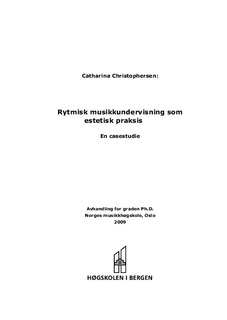Rytmisk musikkundervisning som estetisk praksis : en casestudie
Doctoral thesis
Permanent lenke
http://hdl.handle.net/11250/172647Utgivelsesdato
2009Metadata
Vis full innførselSamlinger
- NMH-publikasjoner [121]
Sammendrag
The subject of this dissertation is rhythmic music teaching. "Rhythmic music" is synonymous with "popular music". Rhythmic music teaching is, in short, an oral approach to teaching, where rhythm, participation, movement, improvisation and playing together are essential. The purpose of the study is to examine how rhythmic music teaching is constituted as aesthetic practice. My research questions are: How are aesthetic values expressed in rhythmic music teaching, and how are these values constituted as self-evident?
I designed the study as a case study of a percussionist, Tobias, who teaches at a Danish rhythmic conservatory. Data have been collected through participant observation, interviews and document studies. The theoretical point of departure is Pierre Bourdieu's theory of social practice; habitus, practical sense, doxa and illusio have been useful concepts in the analysis. I have applied Maurice Merleau-Ponty's phenomenology of the body and John Dewey's pragmatism as supplements to Bourdieu's somewhat structural orientation. This enabled me to identify aesthetic values in rhythmic music teaching, as seen from the agent's point of view. In order to examine how these values are constituted as self-evident, I identified various objective structures; in teaching situations, in narratives, and in structures within the conservatory context. I found that these structures to a large degree coincided with and mirrored the aesthetic values as expressed and exercised in the classroom. I also identified various social control mechanisms; in some cases subtly and efficiently transformed into self- limitation and self-control. As a consequence, these structures and mechanisms function to maintain the given aesthetic order, thereby reproducing aesthetic practice. The coinciding of incorporated and reified structures produces a coherent belief system. Inside such a belief system, the rhythmic activity - and thus also the aesthetic values - appears as meaningful, obvious and self-evident. Participatig in music teaching is participating in aesthetic practice, which implies an incorporation of aesthetic values. To incorporate aesthetic values is to incorporate guidelines for taste and action, which has both ethical and epistemological implications: It forms the perception of what is legitimate, and, consequently, what the individual may be required to learn, know, believe and think, as well as what he or she may require of themselves and of others.
Beskrivelse
Avhandling (Ph.D.) - Norges musikkhøgskole, 2009
